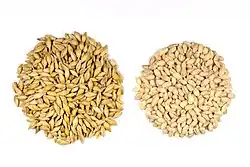Multigrain flour

Multigrain flour is a blend of two or more different grains, offering a more complex nutritional profile than single grain flours.[1] It usually consists of a blend of whole grains, such as barley, oats, wheat, and millets, and occasionally even pulses or other legumes. This mixture can improve the nutritional content of baked goods and other dishes.[2]
Multigrain flour usually has a coarser texture and a more dense, hearty consistency than all-purpose flour, due to the presence of different grains.[3][4] The particular consistency may change depending on the grain mixture and milling process. Some multigrain flours may absorb more water than others, particularly those made with whole grains, hence requiring modifications made to hydration levels in recipes.[4][5]
More specifically, grain types (such as wheat, rye, oats, etc.) and whether they are whole or refined may affect the texture of the flour and its behavior in baking.[4] Also, the method used to grind the grains, such as roller milling or stone grinding, affect the fineness and consistency of the flour.[3][6] In general, more water is needed to make a dough with a whole grain flour than with a refined flour.[7] When preparing the dough, adding other grains, seeds, or flakes might also change the texture of the flour.[4]
Common grains used in multigrain flours are barley, oats, whole wheat, millets, corn, rye, spelt, and buckwheat.[1][2] In general, there are 7-grain atta, 5-grain atta, and high fiber atta. A 7-gain atta contains a combination of seven different grains, offering a diverse nutrient profile and slightly nutty flavor. A 5-grain atta is a combination of five whole grains that offers a somewhat earthy flavor and a balanced nutritional profile. And a high fiber atta is a flour specially made with high-fiber grains to improve the health of the digestive system and encourage the feeling of fullness.[2] One of the primary components of all multigrain flours is whole wheat, which provides fiber and many nutrients.[8][9]
Multigrain flour offers several health benefits due to its high fiber content, vitamin richness, and potential to promote weight control and digestive health.[10] More specifically, multigrain flour is rich in soluble and insoluble fiber, which helps maintain regular bowel movements, avoid constipation, and support the overall digestive health.[1] In addition, foods high in fiber, such as multigrain flour, can prolong the feeling of fullness, which may help in the weight management and in the prevention of overeating. Compared to refined flour, multigrain flour typically has a lower glycemic index, which means that it releases glucose into the bloodstream more gradually and helps to avoid blood sugar spikes.[11][12][13]
Other health benefits include the lowering of LDL cholesterol levels, potentially reducing the risk of heart disease.[2] Finally, multigrain flours contain various vitamins and minerals, including B vitamins, iron, magnesium, and zinc, which are important for overall health and well-being.[14]
- Some of the basic grains used to produce a multigrain flour.
-
 Barley grains with and without the outer husk.
Barley grains with and without the outer husk. -
 Different types of rye.
Different types of rye. -
 Grains of wheat, rye and their hybrid, triticale. Triticale is significantly larger than wheat.
Grains of wheat, rye and their hybrid, triticale. Triticale is significantly larger than wheat. -
.jpg) Black oat grains.
Black oat grains. -
 Millet grains.
Millet grains.
See also
References
- ^ a b c "Multigrain Flour: Ingredients, Health Benefits & How to Use It". Rotimatic. 2024-03-18. Retrieved 2025-08-11.
- ^ a b c d "The Ultimate Guide to Multigrain Atta: Benefits, Usage, And Recipes". Aashirvaad Chakki. 2023-12-18. Retrieved 2025-08-11.
- ^ a b "Revolutionizing Health and Business: The Multigrain Flour Mill, A Path to Nutritional Richness". www.iid.org.in. Retrieved 2025-08-11.
- ^ a b c d Villa, Emanuele (2025-06-28). "Multigrain Dough: What It Is, Its Benefits, and Why It's Perfect for Pinsa". Di Marco. Retrieved 2025-08-11.
- ^ Flour, Prima (27 January 2025). "Exploring Different Types of Flour: Whole Grain Vs. All-Purpose". Prima Flour. Retrieved 2025-08-11.
- ^ Din, Ghulam Mueen Ud; Usmani, Wardha; Hussain, Ashiq; Bilal, Muhammad; Najam, Ayesha; Zia, Muhammad; Raza, Muhammad Siddique; Aziz, Tariq; Zahra, Nureen; Alshammari, Jaza Maqbl; Alharbi, Mudi H.; Al-Asmari, Fahad (2025-04-01). "Effect of multigrain flour mixes on the physicochemical, nutritional, textural, and sensory quality of cake rusks". Italian Journal of Food Science. 37 (2): 261–275. doi:10.15586/ijfs.v37i2.2921. ISSN 1120-1770.
- ^ "Baking Bread with Whole-Grain Flours". Anova Culinary. 2023-11-14. Retrieved 2025-08-11.
- ^ "Multigrain Flour Benefits for Health, Weight loss and Digestion". HIMALAYAN CHEF PAKISTAN. 2025-06-16. Retrieved 2025-08-11.
- ^ "Homemade Multigrain Flour". The Woks of Life. 30 September 2020. Retrieved 2025-08-11.
- ^ "Amazing health benefits of eating Multigrain Atta, you did not know!". Aazol: Home-grown Foods of Maharashtra. 21 December 2023. Retrieved 2025-08-11.
- ^ Sobhana, Prasanthi Prabhakaran; Kandlakunta, Bhaskarachary; Nagaraju, Raju; Thappatla, Deepika; Epparapalli, Srinivas; Vemula, Sudershan Rao; Gavaravarapu, Subba Rao M.; Korrapati, Damayanti (2020). "Human clinical trial to assess the effect of consumption of multigrain Indian bread on glycemic regulation in type 2 diabetic participants". Journal of Food Biochemistry. 44 (11): e13465. doi:10.1111/jfbc.13465. ISSN 1745-4514. PMID 33006193.
- ^ Călinoiu, Lavinia Florina; Vodnar, Dan Cristian (2018-11-01). "Whole Grains and Phenolic Acids: A Review on Bioactivity, Functionality, Health Benefits and Bioavailability". Nutrients. 10 (11): 1615. doi:10.3390/nu10111615. ISSN 2072-6643. PMC 6265897. PMID 30388881.
- ^ Tighe, Paula; Duthie, Garry; Vaughan, Nicholas; Brittenden, Julie; Simpson, William G; Duthie, Susan; Mutch, William; Wahle, Klaus; Horgan, Graham; Thies, Frank (2010-10-01). "Effect of increased consumption of whole-grain foods on blood pressure and other cardiovascular risk markers in healthy middle-aged persons: a randomized controlled trial123". The American Journal of Clinical Nutrition. 92 (4): 733–740. doi:10.3945/ajcn.2010.29417. ISSN 0002-9165.
- ^ "Multigrain Atta - Everything You Need to Know : Benefits, Ingredients, Composition". Two Brothers Organic Farms. Retrieved 2025-08-11.